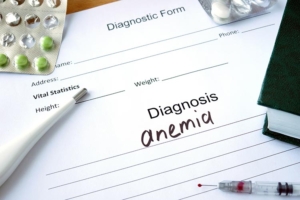&

People on dialysis often struggle with anemia. Their kidneys struggle to produce erythropoietin, which is responsible for stimulating
red blood cell production. Furthermore, absolute and functional iron deficiency can develop due to poor diet, inflammation, and blood loss.
That is why eating a well-balanced, nutrient-dense diet is important with an emphasis on getting the crucial nutrients for red blood cell production:
- Protein
- Iron
- Folate
- Vitamin C
With grocery bills on the rise, it’s important to focus on budget-friendly strategies to pack in as many nutrients as possible without breaking the bank.
Read on to learn about cost-saving strategies.
Shop the Freezer Aisle
We often hear that to shop healthy we should stick to the perimeter of the grocery store where the freshest foods are found. But the freezer aisle hides
a lot of gems, specifically frozen fruits and vegetables. Frozen spinach, peas, green beans, and broccoli offer a source of non-heme iron while frozen fruits like strawberries, peaches, and cherries offer a good source of vitamin C.
Unlike their fresh counterparts, frozen foods might be easier to use when you only want a small amount because you do not need to thaw the whole bag,
just the amount you want for one serving. This will prolong the shelf-life, meaning the food won’t go bad before you can use it.
Shop Seasonal
Another way to save is to focus on buying produce while it’s in season. Often, the prices will be marked down to help stores sell a large volume of produce during their peak harvest times. As we move into summer, berries, tomatoes, peas, green beans, stone fruits, and peaches will all be coming into season
to keep an eye out for deals!
But it’s not just vegetables and fruit that have a seasonal pattern when it comes to cost, meat does as well. Meat is rich in heme iron and high biological value protein, but there are certain times of year you can expect the cost of certain meats to rise. During the summer and around the winter holidays, beef will likely be at peak prices. This could be a good time to choose alternatives like poultry or fish. In January, chicken prices also rise and are lowest in February and December. You may also find sales during the summer months.
To take advantage of lower prices and preserve food from spoiling, stock up on both produce and meat when prices are lower and freeze a large portion
if freezer space is available. Uncooked meat can be stored in the freezer for 4-12 months and ground meat for 3-4 months. Fruits and vegetables are usually safe in freezer storage for 8-12 months.
Use Iron Pots and Pans
Cooking with iron pots and pots or putting an iron ingot into pans while food cooks has shown to increase iron content in those foods.
The rise in iron content has been associated with improved hemoglobin levels. It works with both meat and vegetables.
Mix Up Your Proteins
Combining the power of meat and plant-based proteins can have a multitude of benefits, including for anemia management. While non-heme iron found
in plant-proteins like beans and lentils is less bioavailable, consuming these foods with meat that has more bioavailable iron, has shown to increase absorption of both kinds of iron. This also works well for a budget, to make the more expensive meat stretch into multiple meals, a dish can be bulked up with beans. This leads to a larger volume of food, more fiber, and better iron absorption. It’s a win-win-win!
Shopping for health can be budget-friendly with a little knowledge and planning. However, some patients on dialysis may still struggle to get the nutrition they need even with access to food and first-line nutrition tools. That’s when IDPN for HD or IPN for PD may be appropriate. To learn how IDPN may support anemia management and other resources, visit our Clinician Portal.
We thank our guest blogger Maiya Slusser, MS, RDN, CD, CNSC, for sharing her knowledge and writing this blog post!

